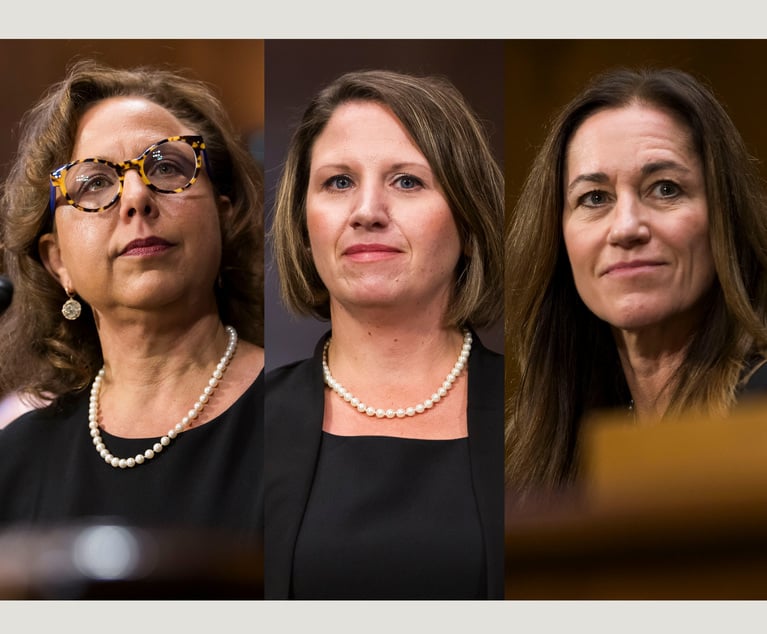Antitrust Agency Turf War Over Big Tech Investigations
The Federal Trade Commission and the Department of Justice have found themselves under the microscope as calls for antitrust investigations into "Big Tech" companies escalate.
October 04, 2019 at 02:57 PM
10 minute read
 Carl W. Hittinger (left) and Tyson Herrold (right) of Baker & Hostetler.
Carl W. Hittinger (left) and Tyson Herrold (right) of Baker & Hostetler.
The Federal Trade Commission and the Department of Justice have found themselves under the microscope as calls for antitrust investigations into "Big Tech" companies escalate. The agencies, which share civil antitrust enforcement authority, are reportedly engaged in a turf war over investigations of companies operating in the social media, online retail, search engine and app store space. In September, FTC Chairman Joseph Simons reportedly sent a letter to Assistant Attorney General Makan Delrahim expressing concern about the agencies' interactions. Meanwhile, they both appear to be investigating the same Big Tech companies, contrary to a clearance agreement penned by the agencies in 2002 and, reportedly, a more recent agreement concerning Big Tech. What is causing this largely uncharacteristic dispute and what effect will it have on enforcement?
The Agency Clearance Process
As we discussed in June 2018, because the FTC and DOJ have concurrent civil antitrust jurisdiction, they rely on a clearance agreement to coordinate their authority. The current agreement's Appendix A seeks to prevent disputes by assigning particular industries to each agency. The quasi-independent, consumer-protection-focused FTC generally monitors industries that, as Simons recently put it, "most directly affect consumers and their wallets." By contrast, the DOJ, an executive branch law enforcement agency, generally oversees less consumer-facing industries and sectors impacting national defense.
Because Appendix A is perfunctory, however, disputes frequently arise where a company targeted for investigation falls between Appendix A's cracks or, more commonly, straddles more than one industry. The clearance agreement lists criteria for resolving these disputes. Emphasizing specialization and conservation of resources, it grants priority to the agency "with expertise in the product or similar product … gained through a substantial antitrust investigation … within the last seven years." The agreement also enumerates a list of tie-breaking factors; for example, an agency gets more "expertise" credit if a case was litigated to verdict than if it was filed and later settled. While the vast majority of disputes are settled with Appendix A and the tie-breaking criteria, disagreements may also be settled through a neutral evaluator and, ultimately, upon elevation to the FTC chairperson and the assistant attorney general for the Antitrust Division of the DOJ.
Conflicts Over Investigations Into Big Tech
The agencies' turf war over Big Tech suggests they may be struggling to apply the aging clearance agreement to companies and business models that were somewhat embryonic when it was drafted in 2002. For example, social media is not explicitly addressed in the agreement, and there appears to be no obvious analogue to it in Appendix A. Although there are reports that the FTC and DOJ struck a new clearance deal concerning Big Tech, there are bound to be hiccups. U.S. Sen. Mike Lee, chairman of the Senate Subcommittee on Antitrust, Competition Policy, and Consumer Rights, said last month: "What's evident from this latest institutional tug of war is that the Antitrust Division of the DOJ and the FTC are now actively battling each other to take the lead in pursuing Big Tech."
However, the emergence of Big Tech does not fully explain the discord. This summer, the DOJ and FTC publicly clashed in the FTC's monopolization case against cellular chipmaker Qualcomm—a quarter-century old enterprise whose product seems to fit neatly within Appendix A's framework. The case was filed by a divided FTC commission in the waning days of the Obama administration, alleging the company licensed standard essential patents in an anticompetitive fashion. The district court ruled in the FTC's favor, but, on Qualcomm's appeal, the DOJ filed an amicus brief siding with Qualcomm's request for a stay of the lower court's ruling. It argued: "Immediate implementation of the remedy could put our nation's security at risk, which is vital to military readiness and other critical national interests."
More importantly, because the standard for a stay requires a peek at the merits of Qualcomm's appeal, the DOJ found itself in the unusual position of undermining the FTC's case: "Qualcomm is likely to succeed on the merits because the district court's decision ignores established antitrust principles and imposes an overly broad remedy." The FTC responded in its opposition brief that the DOJ "mischaracterized" the district court's analysis, that it offered "unsubstantiated concerns" about R&D, and that it essentially asserted that Qualcomm should be immune from antitrust scrutiny.
Given the current political emphasis on a variety of real or perceived controversial competition issues, it is no wonder the FTC and DOJ have prioritized investigatory action over fidelity to the clearance process. As Sen. Amy Klobuchar, ranking member of the Senate Subcommittee on Antitrust, Competition Policy, and Consumer Rights, said in a September hearing, "I'd rather have a split investigation between the DOJ and FTC than no investigation." The clearance agreement itself says: "Each agency nevertheless retains full responsibility and authority for the discharge of its statutory duties."
Finally, as former FTC chairman and architect of the clearance agreement Timothy Muris has pointed out, "parochial interests" also necessarily play a role in the clearance process. During the ABA's 2004 Antitrust spring meeting, Muris remarked: "I have talked to you about the clearance issue, and 90% of you were opposed to the resolution that the DOJ and I reached. The reason is you thought your agency, whatever agency you were from, got the worst of the deal. There are three classes of cases: there are the ones that clearly go to the FTC; there are the ones that clearly go to the DOJ; and there are the ones that are in dispute. If you think the ones in dispute belong to your agency, clearly it was a bad deal. That is the overwhelming view of the alumni that I have talked to from both agencies."
September's Senate Antitrust Oversight Hearing
As has been widely reported, Big Tech clearance disputes played a role in a Sept. 17 Senate oversight hearing held by the Senate Subcommittee on Antitrust, Competition Policy, and Consumer Rights, which was attended by Simons and Delrahim. In opening remarks, Sen. Mike Lee chastised the agencies: "In the past, the agencies have avoided too much mischief because they've generally played well together. Recently, this appears quite regrettably to have changed. From what I can tell, clearance disputes have become more frequent, more pronounced and more prolonged."
Lee asked Delrahim and Simons whether the FTC and DOJ were still operating under the "clearance system to avoid duplicative efforts or have things broken down on this front?" Simons responded, "for the vast majority of matters, we continue to operate under the existing clearance agreement," but, upon further questioning, agreed with Lee that "things have broken down at least in part." Delrahim added: "I cannot deny that there are instances where Chairman Simons' and my time is wasted on those types of squabbles."
Lee also quizzed the agency heads whether, hypothetically, if they were asked to provide "advice on setting up an antitrust regime in another country … that didn't already have one, would you under any circumstances recommend that they follow the U.S. model and that they have two separate agencies responsible for civil antitrust enforcement?" Simons responded flatly: "No, I wouldn't." Delrahim remarked, "it would be hard to imagine a system being designed at the first instance like we have today." He conceded: "It's not the best model of efficiency."
The Hazards of Clearance Disputes
Disputes over clearance can have tangible adverse effects on enforcement. First, some have commented that delays caused by clearance disputes can narrow the efficacy of remedial options, particularly with mergers. As Sen. Richard Blumenthal has commented, "The Big Tech companies are not waiting for the agencies to finish their cases. They are structuring their companies so that you can't unscramble the egg." Structural remedies are favored by Delrahim, who has commented that alternative, behavioral remedies should be used sparingly: "The division has a strong preference for structural remedies over behavioral ones. … The Antitrust Division is a law enforcer and, even where regulation is appropriate, it is not equipped to be the ongoing regulator."
Second, disputes over clearance and, more so, duplicative investigations waste agency resources, threaten to blunt their effectiveness and can lead to inconsistent and confusing governmental positions. In the Sept. 17 oversight hearing, Simons and Delrahim were both criticized for requesting an increase in funding: "As you both acknowledged, both of you could use, and desperately need, more resources. That being the case, it makes no sense to me that we should have duplication of effort, when that has a tendency inevitably to undermine the effectiveness of what you're doing." Duplicative investigations dilute the specialization that is a principle goal of the agencies' clearance agreement and raise the risk that one agency will take legal positions that undercut the other. No doubt the DOJ's amicus brief in the Qualcomm case influenced the U.S. Court of Appeals for the Ninth Circuit's decision to issue a stay pending appeal.
So how will the FTC and DOJ resolve their latest turf war? Perhaps they will revisit their clearance agreement and decide to split their authority by company or the business practice being investigated, based on prior agency experience, rather than by industry as Appendix A currently does. Or maybe Congress will decide to consolidate civil antitrust enforcement jurisdiction under one agency. That seems like a long shot considering the political implications. However, during the Senate's antitrust oversight hearing, Sen. Josh Hawley proposed "cleaning up the overlap in jurisdiction by removing it from one agency" and "clearly designating enforcement authority to one agency." One thing is sure—the agencies should not be duplicating civil antitrust investigations. Stay tuned.
Carl W. Hittinger is a senior partner and serves as BakerHostetler's antitrust and competition practice national team leader and is the litigation group coordinator for the firm's Philadelphia office. He concentrates his practice on complex commercial and civil rights trial and appellate litigation, with a particular emphasis on antitrust and unfair competition matters, including class actions. His experience also includes a judicial clerkship with Chief Judge Emeritus Louis C. Bechtle of the U.S. District Court for the Eastern District of Pennsylvania. He can be reached at 215-564-2898 or [email protected].
Tyson Y. Herrold is an associate in the firm's Philadelphia office in its litigation group. His practice focuses on complex commercial litigation, particularly antitrust and unfair competition matters, as well as civil rights litigation. Immediately before joining the firm, he clerked for Judge Dolores K. Sloviter of the U.S. Court of Appeals for the Third Circuit, serving during her last year on the bench.
This content has been archived. It is available through our partners, LexisNexis® and Bloomberg Law.
To view this content, please continue to their sites.
Not a Lexis Subscriber?
Subscribe Now
Not a Bloomberg Law Subscriber?
Subscribe Now
NOT FOR REPRINT
© 2025 ALM Global, LLC, All Rights Reserved. Request academic re-use from www.copyright.com. All other uses, submit a request to [email protected]. For more information visit Asset & Logo Licensing.
You Might Like
View All
Pa. Federal District Courts Reach Full Complement Following Latest Confirmation

The Defense Bar Is Feeling the Strain: Busy Med Mal Trial Schedules Might Be Phila.'s 'New Normal'
7 minute read
Federal Judge Allows Elderly Woman's Consumer Protection Suit to Proceed Against Citizens Bank
5 minute read
Judge Leaves Statute of Limitations Question in Injury Crash Suit for a Jury
4 minute readTrending Stories
- 1African Law Firm Investigated Over ‘AI-Generated’ Case References
- 2Gen AI and Associate Legal Writing: Davis Wright Tremaine's New Training Model
- 3Departing Attorneys Sue Their Former Law Firm
- 4Pa. High Court: Concrete Proof Not Needed to Weigh Grounds for Preliminary Injunction Order
- 5'Something Else Is Coming': DOGE Established, but With Limited Scope
Who Got The Work
J. Brugh Lower of Gibbons has entered an appearance for industrial equipment supplier Devco Corporation in a pending trademark infringement lawsuit. The suit, accusing the defendant of selling knock-off Graco products, was filed Dec. 18 in New Jersey District Court by Rivkin Radler on behalf of Graco Inc. and Graco Minnesota. The case, assigned to U.S. District Judge Zahid N. Quraishi, is 3:24-cv-11294, Graco Inc. et al v. Devco Corporation.
Who Got The Work
Rebecca Maller-Stein and Kent A. Yalowitz of Arnold & Porter Kaye Scholer have entered their appearances for Hanaco Venture Capital and its executives, Lior Prosor and David Frankel, in a pending securities lawsuit. The action, filed on Dec. 24 in New York Southern District Court by Zell, Aron & Co. on behalf of Goldeneye Advisors, accuses the defendants of negligently and fraudulently managing the plaintiff's $1 million investment. The case, assigned to U.S. District Judge Vernon S. Broderick, is 1:24-cv-09918, Goldeneye Advisors, LLC v. Hanaco Venture Capital, Ltd. et al.
Who Got The Work
Attorneys from A&O Shearman has stepped in as defense counsel for Toronto-Dominion Bank and other defendants in a pending securities class action. The suit, filed Dec. 11 in New York Southern District Court by Bleichmar Fonti & Auld, accuses the defendants of concealing the bank's 'pervasive' deficiencies in regards to its compliance with the Bank Secrecy Act and the quality of its anti-money laundering controls. The case, assigned to U.S. District Judge Arun Subramanian, is 1:24-cv-09445, Gonzalez v. The Toronto-Dominion Bank et al.
Who Got The Work
Crown Castle International, a Pennsylvania company providing shared communications infrastructure, has turned to Luke D. Wolf of Gordon Rees Scully Mansukhani to fend off a pending breach-of-contract lawsuit. The court action, filed Nov. 25 in Michigan Eastern District Court by Hooper Hathaway PC on behalf of The Town Residences LLC, accuses Crown Castle of failing to transfer approximately $30,000 in utility payments from T-Mobile in breach of a roof-top lease and assignment agreement. The case, assigned to U.S. District Judge Susan K. Declercq, is 2:24-cv-13131, The Town Residences LLC v. T-Mobile US, Inc. et al.
Who Got The Work
Wilfred P. Coronato and Daniel M. Schwartz of McCarter & English have stepped in as defense counsel to Electrolux Home Products Inc. in a pending product liability lawsuit. The court action, filed Nov. 26 in New York Eastern District Court by Poulos Lopiccolo PC and Nagel Rice LLP on behalf of David Stern, alleges that the defendant's refrigerators’ drawers and shelving repeatedly break and fall apart within months after purchase. The case, assigned to U.S. District Judge Joan M. Azrack, is 2:24-cv-08204, Stern v. Electrolux Home Products, Inc.
Featured Firms
Law Offices of Gary Martin Hays & Associates, P.C.
(470) 294-1674
Law Offices of Mark E. Salomone
(857) 444-6468
Smith & Hassler
(713) 739-1250





